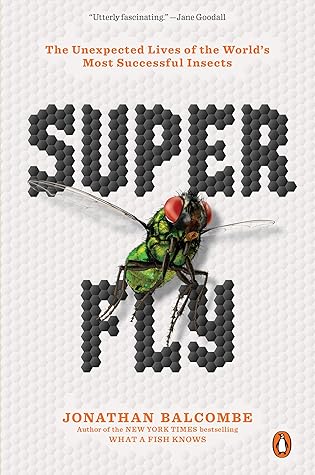Kindle Notes & Highlights
Read between
October 11 - November 10, 2022
flies seem incapable of becoming sickened by their diets.
While the maggots munch away, they also secrete or excrete a stew of antimicrobial molecules that can kill certain bacteria.
anthropomorphic hogwash;
Mutualisms—in which two or more organisms benefit by associating with one another—provide
Of the 150 described families of Diptera, at least 71 include flies that feed at flowers as adults.
80 percent of species that humans define as food plants, rely on pollinators. Less than 7 percent of these food plants are pollinated solely by wind or water, less than 4 percent by birds, and less than 2 percent by bats, leaving close to 90 percent pollinated by insects.*
David MacNeal
Bugged
“Bugs are nearly as necessary to humans ...
This highlight has been truncated due to consecutive passage length restrictions.
By most estimates (so far), the Hymenoptera (bees and wasps) outrank flies (Diptera), beetles (Coleoptera), and butterflies and moths (Lepidoptera) as pollinators of flowers.
In arctic and alpine environments, for instance, where weather conditions suppress bee activity, flies are often the main pollinators.
“Flies widely replace bees as main flower visitors at altitude.”
two thirds of the fly sample in one study, 643 individuals belonging to 85 species—were not flower flies.
As Aristotle noted nearly 2,400 years ago when he coined the name diptera, “No two-winged insect has a sting at the rear.”
Many of our favorite fruits are at least partly pollinated by flower flies, including apple, pear, strawberry, mango, cherry, plum, apricot, raspberry, and blackberry.
early autumn pawpaws
Flies also pollinate herbs and vegetables, including fennel, coriander, caraway, onions, parsley, and carrots.
In all, more than 100 cultivated crops are regularly visited by flies and depend largely on fly pollination for abundant fruit set and seed production.
cacao is unable to fertilize itself and therefore requires insects for successful pollination.
With the possible exception of one species of flower fly, only very small midges are known to pollinate the penny-size, whitish-pink flowers emerging directly from the cacao plant’s trunk and lower branches.
Although cacao trees can produce prodigious numbers of flowers, even with the midges’ assistance only a tiny fraction of these will ever grow into a mature cacao pod.
Tiny midges are the only insects known to pollinate the complicated flower of the cacao tree, from whose fruit chocolate is made.
It took me an hour to extract the golden pockets of meat nestled amid the fibrous tissue,
“Flowers want their visitors to keep visiting other flowers of their own species,” Mark Deyrup told me. “This is one reason why the physical appearance of flowers is highly consistent within species (barring manipulation by gardeners) and distinctive across species. Insects who visited different flowers on single foraging bouts wouldn’t be spreading much pollen to the right places. Flowers teach generalist insects to be active specialists.”
The phenomenon by which pollinators tend to visit flowers of the same species, even where more profitable nectar sources are available, is called flower constancy.
When Charles Darwin described flowers whose nectar reservoirs could be reached only through a narrow two-inch flower tube, he famously predicted that there must be some undiscovered insect with an equally long tongue. It was many years after Darwin’s death before such insects were discovered. The meganosed fly (Moegistorhynchus longirostris) of southern Africa, outdoing its literary counterpart Pinocchio, has a noselike proboscis that is actually the longest mouthpart—a tonguelike drinking tube—of any known fly
there are flower flies and soldier flies that practice floral larceny by stealing nectar from heliconia flowers without aiding pollination.
You may have heard of orchids that display plump flowers resembling the abdomens of female bees, which are irresistible to male bees.
Some orchids direct their seductive tactics at flies.
kleptoparasitism—the stealing of food caught by another predator. They can be found brashly snacking on the prey suspended in a spider’s web.
Plants that encourage this kind of behavior are called kleptomyiophiles, “lovers of thieving flies.”
The small quantities of proteins produced by these flowers suggest that they are “food deceptive.”
In the purely biological context, flowering evolved to facilitate the transference of gametes between individuals to achieve cross-fertilization.
Less formally, flowers represent mechanisms evolved to exploit third parties, mostly insects, to aid plant sex.
The deception must be convincing and alluring enough to dupe the insect at least twice, for pollen must be picked up on one flower then deposited on another.
plants that mimic carrion—like those that offer the false promise of sex—typically provide no compensation beyond sensory allurement.
A side note to fly-inspired carrion mimicry in plants is the prevalence of flower gigantism in this assemblage.
Among the credible theories proposed to explain the large-flower phenomenon are that such blooms, whose populations tend to be small and scattered far apart in the forest, need to be able to attract pollinators from long distances, and the long-range scent-sensitive capabilities of blowflies fit the bill.
fungus gnats are a large group, numbering over 5,000 described species,
Some fungi have become so codependent on their partner gnats that, like certain fruits and their pollinators, their spores can germinate only after passing through a gnat maggot’s gut.
delicate mountain midges. The time from their aquatic emergence through mating and egg-laying to death is less than two hours.
Romeo laments that “more courtship lives in carrion flies than Romeo,”
Signal flies and picture-winged flies combine visual, tactile, gustatory, and probably olfactory and acoustic elements in their multisensory courtships. These flies are named for their prominently patterned wings, each of
which they vigorously twist and flex, each independently of the other, in a motion that dipterists call paddling.
semaphore ...
This highlight has been truncated due to consecutive passage length restrictions.
eversible
dance flies
A female will not mate with a male who arrives with no gift.
Because many species look nearly identical, species-specific courtship maneuvers can also aid species identification.
Copulation lasts about two hours.


